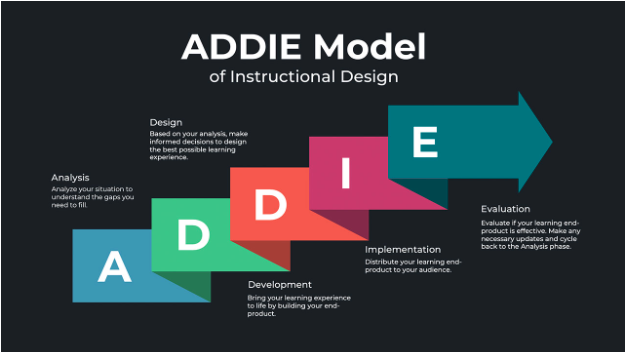Analysis, Design, Development, Implementation, Evaluate (ADDIE)
Star Moretz (Instructional Designer & Training Specialist, College of Engineering)
In the last blog, I briefly mentioned the long standing Instructional Design practice known by the acronym ADDIE. This method was created by The Center for Educational Technology at Florida State University in 1975, for use by the military.
This method is comprehensive and is widely used in higher academia. It is considered to be the gold standard and many simplified versions have sprung up since the inception. It requires extensive time and money to follow the proper protocol of this method. The process follows a specific step by step trajectory; as depicted:

1Image source: Water Bearing Learning
In a broad perspective, one possible negative aspect of the process is that each linear step must be addressed in sequence without any deviation. Another noteworthy mention is that this model stays in the direct hands of the Instructional Designer, where newer spin-offs of the method delegate responsibility for some tasks to stakeholders and users allowing for a faster completion timeframe.
As a faculty member, you might wonder “how can this technical application work for me”? By analyzing your current instructional process in a targeted field/topic/area of interest, you can assess any holes or gaps that are present in your teaching strategy. With the analysis information, you begin to contemplate how you might deliver the information in new or different formats that would reach a larger audience. Asking yourself questions like “am I offering every available mode of delivery; such as visual, auditory, and kinesthetic?”. This leads you to imagine all the ways you can transfer the knowledge, via videos, lectures, and hands-on activities. Not to mention, live and online labs, work study, internships, logs for reflection, blogs and vlogs pertaining to current events, discussion boards and field research. Wow, just think about all the ways to attain knowledge through the distribution of information. Now, you can begin to craft those ideas into lessons, activities, and assessments. After building your course material, you will implement the structures you have created into a classroom setting. Lastly, you will evaluate the success of your endeavor. Did you reach all possible demographics within your class with information that they could process? Did your methodology return positive results from your students? Take what you have learned from this cycle and go back to the analysis stage and proceed again to hone your skills as an instructional designer.
1https://waterbearlearning.com/addie-model-instructional-design/